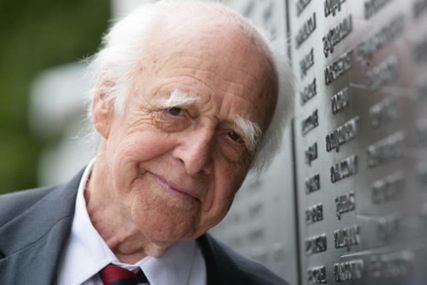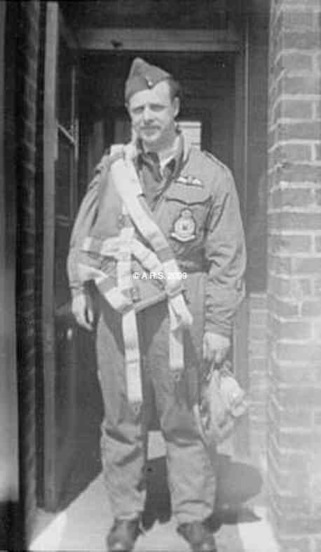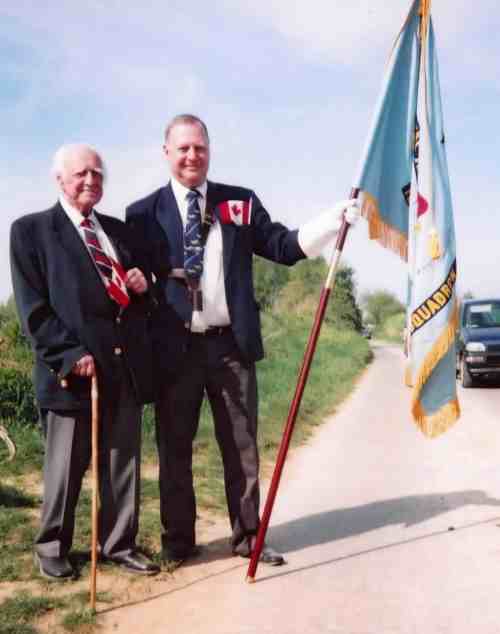VETERAN Royal Air Force Pilot
Battle of Britain Air Gunner (Blenheims)
Leopold Heimes
 Leopold Heimes - the last photo prior to his death 2009 (Courtesy David Mole)
Leopold Heimes - the last photo prior to his death 2009 (Courtesy David Mole)
Leopold Heimes was born on 30 August 1916 at Merbes-le-Château, near Thuin.
In 1927 he became a pupil in Charleroi’s Athénée (secondary school). Showing a marked interest in aviation engineering, he spends his summer holidays with the SAGA firm established on Gosselies airfield. The society’s boss is Cdt Jacquet, the Great War ace.
Later he joins Avions Fairey (also at Gosselies).
Accepted at the Wevelgem E.F.T.S. as a pilot under training, he is sadly struck off the course and joins the air gunners’ course.
(Wevelgem is the airfield serving the town of Courtrai, now Kortrijk in West-Vlanderen).
At the start of the war on 10 May 1940, F/Sgt. (gunner) Heimes is posted to 5th Squadron, III Group, 2nd Aero Regiment based at Nivelles which operates Hispano (engined ?) Fairey Foxes. The squadron moves to the emergency landing grounds at Vissenaken (just west of Tienen/Tirlemont) and then Aalter (between Brugge and Gent), flying from the latter a recce mission with Adjt. Renard.
On 15 May the squadron falls back to France, first to St Omer and then successively to Dreux, Tours and eventually Maugio, near Montpellier. On 21 June he joins a party of pilots and gunners who wish to convert to twin-engined aircraft at Bordeaux. But the instructors have scampered away!
Meanwhile France has signed an armistice. The Belgians desperately wanting to continue the fight in England embark on the M.V. ‘Ettrick’ in St Jean-de-Luz, together with Poles and Czechs, they reach Plymouth on 27 June.
A little later in early July, 124 airmen and candidates are grouped together in England. Only 29 among them are deemed combat-ready.
15 pilots are spread among Fighter Command squadrons flying Hurricanes. The others – pilots, observers and gunners – go to Coastal Command.
Leopold Heimes is posted on 25 August to 235 Squadron as a gunner operating on Blenheims. He flies with Lejeune (pilot) and Michiels (observer). In the same unit, he mixes with Dejace, Dieu D.F.C., Demoulin, Gonay D.F.C., Javaux, Kirkpatrick, Lascot, Prévot D.F.C., Roman D.S.O. D.F.C., Van Waeyenberghe and Venesoen D.F.C.
He takes part in the Battle of Britain while engaged in numerous convoy escort missions and patrols over the Atlantic and the Channel.
On 20 September he is transferred to 272 Squadron at Aldergrove, Northern Ireland, from where he continues flying until April 1941, by which time he is part of a batch of trainee-pilots with Venesoen and Michiels. They receive their ‘wings’ in July 41. (Courtesy David Mole)
(Courtesy David Mole)
In September, W/O Heimes is transferred to 61 O.T.U., Heston for a conversion course on Spitfire. He rejoins 350 (Belgian) Squadron at Valley. In November 1942, he takes a further conversion course on twin-engined aircraft destined for training Coastal Command W/Ops and Navs.
April 1944 finds him at Killadeas, N.I. for a transition course on flying-boats - Catalinas, slow though they may be, nonetheless allow long-range missions to be flown. Ever since the end of the BoB, Coastal Command is engaged in Atlantic patrols to the very limit of their aircraft’s range. Flying by day and by night, they cover thousands of kilometers escorting and protecting convoys.
In November 1945, Heimes converts to the C-47 Dakota and is posted to Poona, India with 76 Squadron.
Recalled to the UK in June 1946, he is then posted to Membury, flying C-47s on 525 Squadron, Transport Command, a unit made up exclusively of Belgian crews. 525 will later form the embryo of the future 15 Transport Wing of the Belgian Air Force. He next goes to 24 Squadron, a unit specialising in V.I.P. flights.
During 1949, he takes part in the Berlin Airlift with 10 Squadron, Transport Command, ending his spell with a move to No.3 Training School to become a Link-trainer instructor. He leaves the R.A.F. only in September 1951, a very rare occurrence. (Courtesy David Mole)
(Courtesy David Mole)
In November 1951 he begins a civilian professional career with the Air Survey Company, specialising in high-altitude air survey flights.
He covers the Himalayan range of mountains and flies over the State of Buthan and Mount Everest.
Once back in Europe (1974), he crosses the Atlantic at the controls of a Dakota to fulfil a contract in the West Indies and South America. He is then sent to the Middle East to fly C-47s operating at 150 ft on geophysical study flights. He travels across Jordan, Kuwait, Dubai, Brunei, Saudi Arabia, Iran, Egypt and Pakistan.
Transferred to Uganda to operate this time at 120 ft over Lake Victoria (Kenya) and in Tanganyka, he is later be based in Northern Ireland in the search for oil fields in the Shetlands, operating as far as 20° W into the Atlantic. All these flights are made at 1,000 ft.
Back in Britain, he is appointed by R.A.E. Farnborough to test-fly new cameras and photographic films at high altitude. He is also one of the pilots who flew C-47s in the shooting of ‘A bridge too far’ (the Battle for Arnhem, Holland).
From 1977 to 1979, Leopold Heimes is a bush pilot flying C-47s in the Sudan and Namibia.
In 1981, back at Farnborough, he test-flies new navigation and recce equipments.
Aged 65 in 1981, he decides to put an end to a long, highly-professional and varied career during which he flew on highly dangerous missions, over out-of-the-way places and into the remotest spots on earth.
Notes – Of the 29 Belgian pilots who took part in the BoB, 7 were to die in that period. Overall, more than 600 Belgians flew in the R.A.F.
Of these, 240 never returned home.
60 of these gallant men were awarded the D.F.C., in addition 2 were awarded the D.S.O. and one warrant officer got a D.F.M.
Sadly Leopold Heimes died early in 2009 but his funeral was honoured with a fly pat of F16's of the Belgian Airforce - such was this respected man.
With thanks to this translation by Jean-Michel Dominique for David Mole.
It is also known that Leopold crossed the English Channel in a microlite whilst in his eighties! Thought as a passenger this time! Leopold Heimes with David Mole holding the 10 Squadron standard at the crash site of JD368 in Belgium. (Courtesy David Mole)
Leopold Heimes with David Mole holding the 10 Squadron standard at the crash site of JD368 in Belgium. (Courtesy David Mole)
